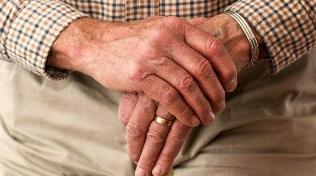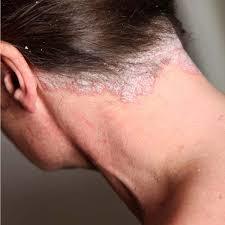A typical symptom of psoriasis is the preferred location of the papules symmetrically on the skin of the extensor surface of the hands and feet, and also on the hair of the head.

Despite the fact that the main role in the development of psoriasis plays a the presence of a genetic predisposition (psoriasis belongs to a disease transmitted by inheritance), the stimulus to the formation of the disease can serve a lot of Exo and endogenous factors (the development of psoriasis in the nervous system, on the background of endocrine disorders, after the delegated infectious diseases and so on).
The etiological factors for the development of the disease
The disease has no sex predisposition, therefore, is the frequency of occurrence of psoriasis in men and women do not differ. In 12 percent of patients the disease first develops up to ten years. Up to twenty years psoriasis develops in forty-six percent of the patients, and up to thirty years at sixty percent.
In the development of psoriasis is celebrating two age peaks:
- twenty-seven and fifty-four years for men;
- fifteen and fifty-four years for women.
Causes of psoriasis in adults
The precise cause of psoriasis is not known. The main role in the pathogenesis of the disease include genetic predisposition. Also, an important role is played by the formation of the immunological instability, lipid violations and the presence of the patient foci of chronic infection.
In favor of genetic theories (inherited causes of psoriasis) is the fact that the disease is always encountered not only in the patient himself, but also his close relatives.
Reveal a predisposition to psoriasis can be used in the implementation of the classical analysis of the genome. These patients may celebrate the ten loci of the chromosomes, which are responsible for genetic predisposition to the disease (PSORS 1 through 9, as well as HLA – B27, 17, etc.).
The main genome responsible for a maximum of expressed innate predisposition to the development of the disease, believe PSORS1.
Also in the pathogenesis of psoriasis play an important role of genetically determined disorders of carbohydrates and lipids. In the majority of patients with psoriasis reveal the severe hyperlipidemia and the metabolic syndrome. In connection with this, in patients with psoriasis noted a high risk of developing severe early atherosclerotic vascular and cardiovascular disease.
In addition to hyperlipidemia, to celebrate the disorders of metabolism LCD (fatty acids), enlarged objects free radical compounds, involved in the keratinization of the epidermis, etc.
In the examination of psoriatic plaques, to draw attention to the great content in them oxidized low-density lipoproteins.
Among the major brands that appreciate the proliferation of keratinocytes in the outbreak of psoriasis are Ki67 is a protein and keratin, six, sixteen and seventeen. It is these brands are responsible for the expressed processes of hyperplasia, disorders of differentiation of cells and for the development of the inflammatory reaction in the dermis.
Whereas, even when the occurrence of the phase I clinical healing with psoriasis (the disappearance of the inflammation from the epidermis) can be an inflammatory process in the blood vessels of the dermis.
Also in the development of inflammation in the outbreak of psoriasis play a role activation of T-lymphocytic cells, neurotransmitters, inflammatory response, inflammation in the microcirculation stream. When examining the skin microflora sheets in patients with psoriasis reveal streptococci, inducing the development of and aggravation of a tear of psoriasis.
Immunological basis of the pathogenesis of the development of psoriasis is a progression of immunocompetent cells, activates SD4+ T-lymphocytic cells and cytokines with anti-inflammatory action. In favor of this theory is evidenced by the fact that monoclonal antibodies with psoriasis, acting against activates SD4+ T-lymphocytic cells, have significant therapeutic effects. Also an effective remedy for psoriasis – it is drugs that focus on inhibiting the formation of factors necrosis factor.
It is contagious, whether it is psoriasis on the skin in the vicinity of
No. Psoriasis is a genetic disease.
Reports whether psoriasis from person to person
No. Gets infected with psoriasis from another person is not possible. Despite the fact that streptococcal infection may act a factor, which causes that individuals without a genetic predisposition to developing the disease, psoriasis appear.
Reports whether psoriasis sexually
No. Psoriasis is not contagious and is not transmitted to neither air-borne nor the pin, nor sexually, nor in some other way.
Reports whether it is psoriasis hereditary
For the development of psoriasis requires a genetic (hereditary) predisposition. Therefore, the disease often occurs in close relatives. In the presence of psoriasis in the parents, the higher the risk of developing psoriasis in a child.
However, some authors issued separately psoriasis the second type. It is believed that this type of psoriasis went patients after forty years, and hitting mainly the joints and the nail plate, it is not associated with heredity.
Can I die from psoriasis
No. Psoriasis is not a life-threatening disease. Prediction for life in these patients is favorable.
However, psoriasis significantly limits the full life of the patient, it gives him a lot of discomfort and reduces his social activity.
Also, it should be noted, that the pustular form of psoriasis may occur, it is very difficult, accompanied by a discharge and suppuration of the pustules, with a further falling away of the skin type of "festering lakes". In this, perhaps, that the development of the erythroderma, secondary bacterial complications, destruction of the joints and so on
Precipitating factors for development of psoriasis
Provoking factors that contribute to the occurrence of exacerbation of psoriasis are:
- injury skin sheets;
- endocrine disorders;
- pregnancy;
- the emergence of metabolic disorders;
- use of the products of beta-adrenoblockers, anti-malarial sw-and so on;
- the availability of foci of chronic infection (particularly streptococcal infection);
- the abuse of liquor;
- smoking;
- an excess of solar radiation;
- consumption of spicy, sweet, fatty, etc food;
- acute infectious diseases;
- exacerbation of allergic diseases;
- stress, emotional overload (scabies in the nervous system escalates most often).
Classification of psoriasis
The varieties emit forms of psoriasis:
- vulgar (common form of psoriasis);
- exudative;
- long-term Palmar-plantar;
- warty;
- follicular;
- nail;
- pustular;
During the disease can wear the progressive, stationary.
On the occurrence of lesions provide a limited, extended, and generalized time.
It may also indicate the seasonality of exacerbations: winter, summer and indefinite (not associated with the time period) exacerbation of psoriasis.
Photo, symptoms and treatment of psoriasis in adults

For psoriasis is characterized by the formation of pinkish, reddish or bright red papules, covered with silvery, whitish scales, loose consistency. Itching of the skin sheets may be missing. Many patients note the emergence of a sense of pressure on the skin.
Intense itch is typical, usually for psoriatic lesions of the skin hair of the head and the crotch.
The emergence of pain in the joints is celebrated in the development of psoriatic arthritis.
The most characteristic manifestation of psoriasis is a triad of specific symptoms :
- the emergence of the phenomenon of stearic spots (amplification peeling at the time of diagnosis of psoriatic papules, causing it becomes similar to stearic acid drops);
- the appearance of the terminal movie (the formation of a fine transparent film, which is after when poskablivanii will be separated all the flaking);
- the formation of a blood rosa or the appearance of spot bleeding at the site of the rejection of the end films.
Psoriatic papules can wear isolated character, or blend. The size can vary from tiny to covering a large area of the skin. The most common localization of papules are the elbows, knees, head (hairy part) and the shoulders.
In rare cases, plaques may hit the mucous membranes of the lips and oral cavity.
In children, patients of advanced age and persons suffering from diabetes, can develop composite form of the disease. In such a case, the affected skin behind the ears, armpits, groin, gluteal pain, around the navel and under the milk glands.
Patients with this psoriasis may be missing a scrub. The surface of the psoriatic outbreak can be totally smooth, bright red. In some cases it is possible the onset of maceration of the folds.
In some patients the only manifestation of the disease may be plaques on the skin and mucous membranes of the genital organs.
As usual, the psoriatic skin lesions are symmetrical, however, some patients can celebrate a one-sided rash. It is also possible the formation of a compound of psoriatic bearings (annular, arcuate, geographical, etc.).
In patients with long current of disease, for a long existing plaques on the skin of the lumbar and gluteus maximus area may be accompanied by the appearance on them of warty growths.
In addition, the causes for the formation of warty form of psoriasis can serve:
- purulent skin infection of the sheets;
- incorrect outdoor treatment (usually me);
- overweight.
In the warty forms of the disease, the flakes begin to stick together among themselves, forming on the surface of the plate yellow scabs.
Some patients may experience isolated flows Palmar-plantar psoriasis. In such a case, the patient tormented by painful cracks, blisters, papules, erythematous-squamous food stamps on the palms and stop.
A frequent manifestation of psoriasis is the defeat of the nail plate. In most cases, they celebrate the formation of spot depressions on the surface of the nail plate (dystrophy). Also can appear the deformation of the nail, longitudinal and transverse striations, thickening of the nail plate, its release and color change, bleeding under the nail plate.
In psoriatic erythroderma, emerging, as usual, on the background of excessive sun exposure or improper external beam therapy, appears a marked swelling of the skin, redness, intense itching and flaking, fever, weakness, appetite disorders. If serious progress is possible the emergence of anemia, heart failure, impaired renal function and liver, occurs with dehydration, alopecia areata.
Psoriasis and pregnancy – the threat to the child, function
Psoriasis does not violate the reproductive function and is not a contraindication to pregnancy. It should be noted that many women during pregnancy, the disease takes place more easily than usual. However, approximately twenty percent of women can mean the expressed exacerbation of the disease.
Overall, psoriasis is not a difficult during pregnancy and is not at risk the child's life. However, in patients with arthritis, increasing the load on the joints, may indicate a significant worsening of the condition. In the generalized forms of pustular psoriasis may emergence of secondary bacterial complications.
It should be noted that because psoriasis is not refers to the infectious disease, the mother can undisturbed make contact with the child and breastfeed breastfeed him. The probability of occurrence of psoriasis in a child in the future is equal to about 15-20%, if he is sick only one parent and about 50%, if they are ill both my parents.
The main complexity with psoriasis in pregnant lies in the fact that jim is contraindicated most appointed medication. So when planning a pregnancy it is necessary to pre-alert your doctor to adjust the treatment.
Ssamolechenie categorically unacceptable and can cause significant damage to mother and child (some drugs have a toxic influence on the fetus).
Diagnosis of the disease
The diagnosis is established on the basis of specific symptomatology (psoriatic triad). And also, if necessary, the date of histological, immunological, radiology research.























